Fall of 1945
Under the Red Cross Flag
The sign of the Red Cross was provided protection from attack for persons injured in war, medical relief personnel, and related facilities. After the bombing, the Red Cross flag and signs were raised over city hospitals, elementary schools and quarantine stations that remained standing after the fire and served as relief hospitals. As a member of the academic survey team's medical group, Kikuchi visited hospitals and relief stations established throughout the city to provide emergency care. The records were seized by the occupation forces and returned in 1973 as copied film. The photographs taken by Kikuchi were included in a large number of reports and publications, conveying the distinctive horror of the atomic bomb's damage and injuries.
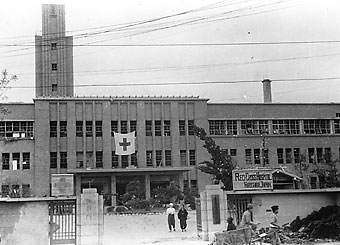 Hiroshima Red Cross Hospital Location: Senda-machi 1-chome Distance from hypocenter: approx. 1.5km Building restoration work for the Hiroshima Red Cross Hospital began during the month after the bombing. The steel window frames were bent inward from the blast, and broken window glass was still scattered. 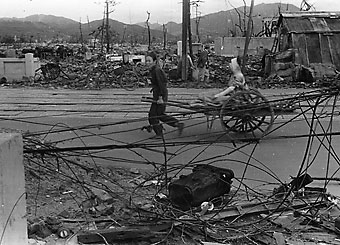 Patient going home in a cart
Location: Senda-machi 1-chome Distance from hypocenter: approx. 1.5km
After being treated for burns, this patient was given a ride home in a cart along the streetcar-line avenue in front of the Hiroshima Red Cross Hospital. Since the patient had been burned in the legs as well and could not walk, a family member pulled the cart each day to and from the hospital. Patient going home in a cart
Location: Senda-machi 1-chome Distance from hypocenter: approx. 1.5km
After being treated for burns, this patient was given a ride home in a cart along the streetcar-line avenue in front of the Hiroshima Red Cross Hospital. Since the patient had been burned in the legs as well and could not walk, a family member pulled the cart each day to and from the hospital.
|
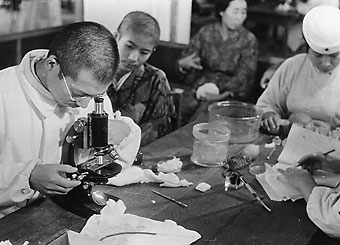 Blood test Location: Hiroshima Red Cross Hospital In mid-September the newspapers reported that the effects of radiation can cause an abnormal drop in the number of white blood cells, so some bomb survivors requested blood testing. This patient is seriously watching the expression on the face of the doctor as the latter looks at a microscope.  Soldier lying down Location: Ujina-machi (now, Ujina-higashi 5-chome) Distance from hypocenter: approx. 4.2km When Kikuchi and his group visited, a decision had already been made to close the Ujina Branch of the Hiroshima First Army Hospital, and only a few soldiers were in the hospital. This soldier was lying impassively and expressionless. He was receiving skin grafts for the burns on his right arm. |
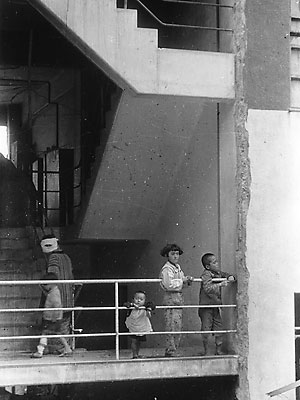 People living at Hiroshima Communications Bureau Location: Moto-machi (now, Higashi-hakushima-cho) Distance from hypocenter: approx. 1.4km The Hiroshima Communications Bureau became a temporary house for some people whose treatment had ended but had no home to return to, as well as for their families. With uncertain prospects for the repair of the buildings, these people were facing the approach of winter, living in the place without windows and doors. |
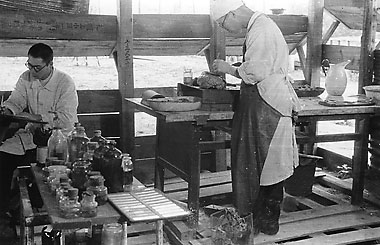 Autopsy at Hiroshima Teishin Hospital Location: Moto-machi (now, Higashi-hakushima-cho) Distance from hypocenter: approx. 1.4km A temporary isolation ward was used to perform autopsies of people who died from the atomic bomb. Autopsies continued day after day until late at night, with the number reaching thirty. |
|||
 Boy transported by cart to Oshiba relief hospital Location: Oshiba Elementary School Oshiba-cho (now, Oshiba 1-chome) Distance from hypocenter: approx. 2.4km A young boy who had severe burns on both legs received medical treatment while still lying in a cart. At the time, there were few medical institutions that could provide medical care, and many patients had to travel from far away. |
||||
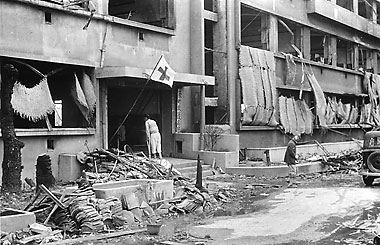 Entrance to Fukuromachi relief hospital Location: Fukuromachi Elementary School Fukuro-machi Distance from hypocenter: approx. 460m Shortly after the bombing, Fukuromachi Elementary School became a relief station where many victims gathered. The Hiroshima Prefecture's Health Division and the city health center set up offices on the second floor; and starting in September, medical treatment was provided by doctors from Hiroshima Prefectural Hospital. |
||||
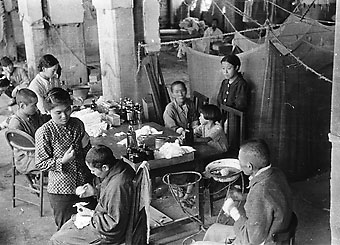 Outpatient treatment at Fukuromachi relief hospital Location: Fukuromachi Elementary School Medical care was provided in classrooms whose concrete interior walls were exposed. Seriously injured persons were accommodated and protected with mosquito netting. In classrooms lacking blackboards and desks, school resumed in May 1946. 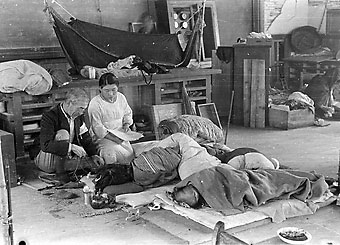 Mother and daughter in Oshiba relief hospital Location: Oshiba Elementary School A mother and daughter during their stay in the Oshiba relief hospital. Being told by the doctors that neither likely had very long to live, Kikuchi and his camera crew once again felt the pain and horror of the atomic bomb. |
 Autopsy at Kusatsu relief hospital Location: Kusatsu Elementary School Kusatsu-higashi-machi (now, Kusatsu-higashi 2-chome) Distance from hypocenter: approx. 4.7km Researchers performing an autopsy on the body of a bombing victim who died the previous day. The body had almost no external injuries, but the internal organs showed abnormalities from radiation. 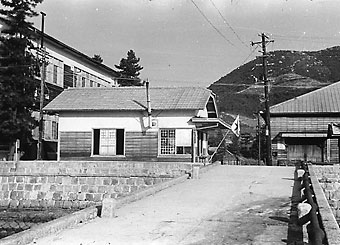 Pier at Ninoshima Quarantine Station which turned into an emergency field hospital Location: Ninoshima-cho Distance from hypocenter: approx. 8.7km Soldiers returning from the front would transfer from a large ship to a barge, and then go ashore from this pier and be quarantined. After the bombing, ships and boats carrying the injured landed one after the other. |
